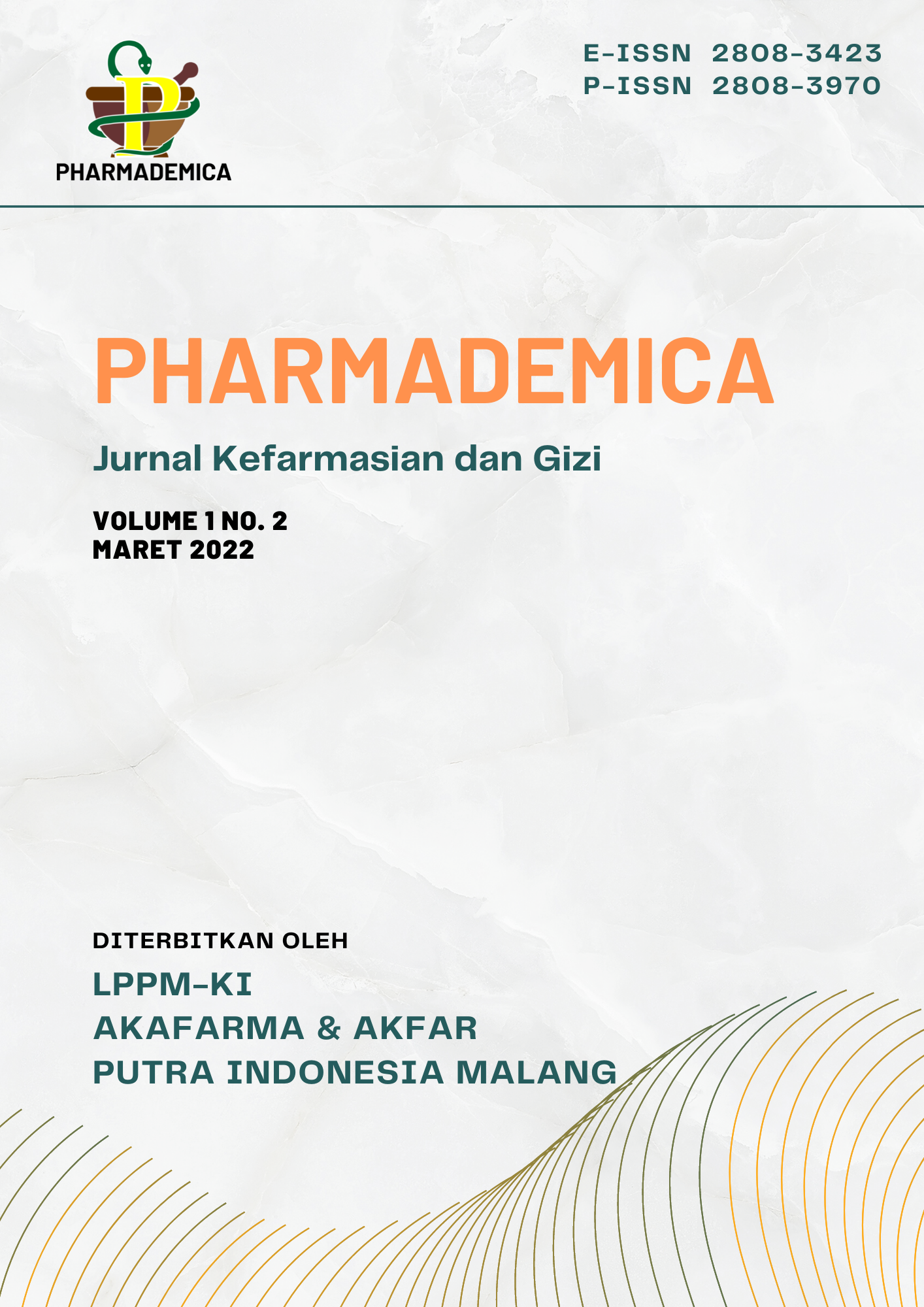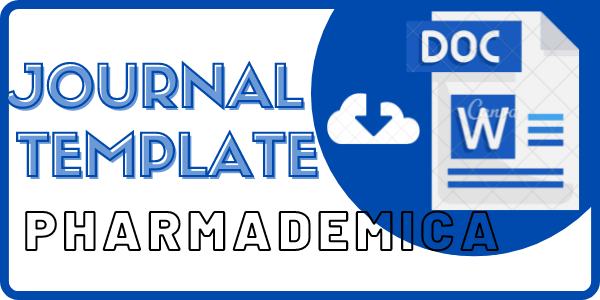Analysis of Retinoic Acid Content on Night Whitening Cosmetic Cream in Malang City
DOI:
https://doi.org/10.54445/pharmademica.v1i2.17
 Abstract View:
Abstract View:
1774
 PDF downloads:
PDF downloads:
7333
Keywords:
Retinoic Acid, Thin Layer Chromatography, Whitening Cream, UV-Vis SpectrophotometryAbstract
Whitening cream is a product that is used on the outside of the body to lighten or change the color of the skin. Whitening cream contains chemicals that are harmful to the skin, such as mercury, hydroquinone, and retinoic acid. Retinoic acid belongs to a group of drugs that are prohibited because it can cause dry skin, burning and teratogenicity. Therefore, it is necessary to analyze the retinoic acid in whitening cream. This study aims to determine the content of retinoic acid in night whitening cream. The samples in this study were 5 night whitening cream products marketed in Malang. Qualitative test of retinoic acid was performed by Thin Layer Chromatography (TLC) with silica gel 60F 254 nm as a stationary phase and n-hexane: acetone (6:4) as a mobile phase, and quantitative test using UV-Vis spectrophotometry. The observation result on TLC shows dark blue spots when viewed under UV light at 254 nm with Rf values for samples B, D, and E of 0.487; sample C of 0.425; while the Rf value of the comparison standard is 0.500. The quantitative test indicates 4 samples of night whitening cream contain retinoic acid; 0.165% in sample B, 0.060% in sample C, 0.125% in sample D, and 0.151% in sample E. In conclusion, samples B, C, D and E do not meet the BPOM requirements because they are sold freely without a doctor's supervision.
Downloads
References
Agustina, Anita S., Choiril HM., M. E. (2019). Analisa Kualitatif Asam Retinoat pada Sediaan Krim Malam di Pasar Klaten dengan Metode Kromatografi Lapis. MOTORIK Journal Kesehatan, 14(02), 136–140. http://ejournal.stikesmukla.ac.id/index.php/motor/article/view/32
BPOM RI. (2007). Kosmetik Mengandung Bahan Berbahaya dan Zat Warna Yang Dilarang: Keputusan Kepala Badan Pengawas Obat dan Makanan Republik Indonesia No. HK.00.01.432.6081, 1 Agustus 2007. Jakarta. Badan Pengawas Obat dan Makanan Republik Indonesia.
BPOM RI. (2011). Metode Analisi Kosmetika Nomor HK.03.1.23.08.11.07331. Badan Pengawas Obat dan Makanan Republik Indonesia.
Das, L., Bhagawati, B., Sarkar, C. R., & Goswami, B. C. (2014). An approach for conversion of retinoic acid to retinyl retinoate using dehydroretinol. Indian Journal of Chemistry - Section B Organic and Medicinal Chemistry, 53(1), 111–114. http://nopr.niscair.res.in/handle/123456789/25326
Gusnedi, R. (2013). Analisis Nilai Absorbansi dalam Penentuan Kadar Flavonoid untuk Berbagai Jenis Daun Tanaman Obat. Pillar of Physics, 2, 76–83. http://ejournal.unp.ac.id/students/index.php/fis/article/viewFile/756/513
Hadriyati, A., Hartesi, B., & Fitri, S. (2021). Analisis Asam Retinoat Pada Krim Pemutih Malam Yang Beredar Di Klinik Kecantikan Kota Jambi Pada Kecamatan Jelutung. Media Farmasi: Jurnal Ilmu Farmasi, 17(1), 1.
Indriaty, S., Hidayati, N. R., & Bachtiar, A. (2018). Bahaya Kosmetika Pemutih yang Mengandung Merkuri dan Hidroquinon serta Pelatihan Pengecekan Registrasi Kosmetika di Rumah Sakit Gunung Jati Cirebon. Jurnal Surya Masyarakat, 1(1), 8. https://doi.org/10.26714/jsm.1.1.2018.8-11
Kim, B., Kim, H., Kim, J. E., & Lee, S. H. (2013). Retinyl retinoate, a retinoid derivative improves acne vulgaris in double-blind, vehicle-controlled clinical study. Tissue Engineering and Regenerative Medicine, 10(5), 260–265. https://doi.org/10.1007/s13770-012-1088-z
Oktaviantari, D. E., Feladita, N., & Agustin, R. (2019). Identification of hydrocuinones in cleaning bleaching soap face at three beauty clinics in Bandar Lampung with thin layer chromatography an UV-Vis spectrophotometry IDENTIFIKASI HIDROKUINON DALAM SABUN PEMUTIH PEMBERSIHWAJAH PADA TIGA KLINIK KECANTIKAN D. Jurnal Analis Farmasi, 4(2), 91–97. http://ejurnalmalahayati.ac.id/index.php/analisfarmasi/article/download/2071/pdf
Saad, A. A., Dalming, T., & Lestari, K. (2019). Analisis Kualitatif Asam Retionat Dengan Metode KLT Pada Sediaan Krim Pemutih Yang Beredar Di Pasar Limbung. Penelitian Kesehatan Pelamonia Indonesia, 02(1), 1–5. http://jurnal.stikespelamonia.ac.id/index.php/jpkpi/article/view/62/57
Suhartini, S., Fatimawali, & Citraningtyas, G. (2013). Analisis asam retinoat pada kosmetik krim pemutih yang beredar di pasaran kota Manado. Jurnal Ilmiah Farmasi, 2(01), 2. https://doi.org/https://doi.org/10.35799/pha.2.2013.879
Wardhani, Y. K., Styawan, A. A., & Mustofa, C. H. (2019). Analisis Kandungan Asam Retinoat Pada Sediaan Krim Malam Yang Beredar Di Toko X Kota Klaten Dengan Spektrofotometri UV-Vis. CERATA Jurnal Ilmu Farmasi, 10(2), 61–66. http://ejournal.stikesmukla.ac.id/index.php/cerata/article/view/79
Wulandari, L. (2011). Kromatografi Lapis Tipis (1st ed.). PT. Taman Kampus Presindo. http://repository.unej.ac.id/handle/123456789/77393
Downloads
Published
How to Cite
Issue
Section
License
Copyright (c) 2022 Fendi Yoga Wardana, Yunida Senja Lestari, Rakhmadani Gadis Aprilianti

This work is licensed under a Creative Commons Attribution-ShareAlike 4.0 International License.









.png)








